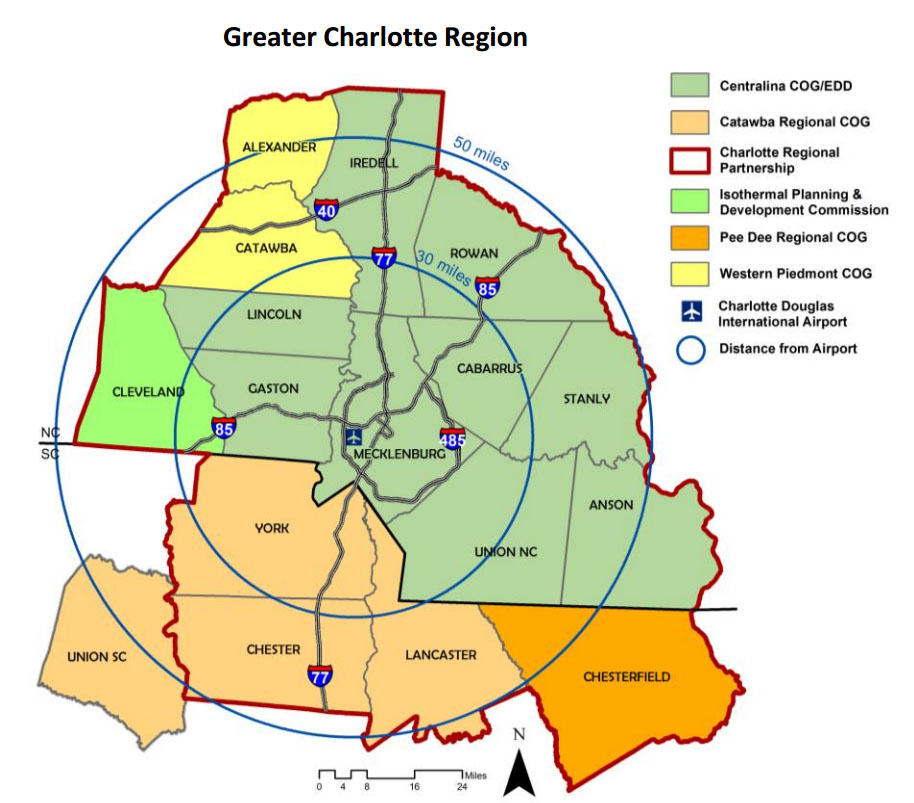A Comprehensive Economic Development Strategy, or CEDS, outlines a regional approach to growing jobs and the economy by building on the region’s strengths, emphasizing key regional industry clusters, and prioritizing economic development projects. CEDS is a program sponsored by the U.S. Department of Commerce Economic Development Administration (EDA). It helps regions and counties strategically align their economic development efforts with information about what industries and industry clusters are growing, what skills the workforce has and will need in the future, what educational programs are offered, and what physical assets exist.
Why is this important to your community?
Our Greater Charlotte Regional economy is no longer solely local or regional. We compete on a global stage to recruit businesses and industries. The CONNECT region is expected to grow by 50% in 20 years and double within 40 years, with 860,000+ new jobs here by 2050. However, for the region’s communities to obtain the maximum benefit from that regional economic growth, it is important that not only the region, but its counties and communities, consider strengths they can build on for economic growth in light of growing industry clusters, and what new strategies may be needed to educate and prepare the workforce for those new jobs. The key to ensuring the economic health and vitality of our communities is to undertake such assessments and planning in a strategic way, and CEDS strategies help counties or groups of communities focus on intentional economic development and business growth efforts, which help increase the chances of successful recruitment and local job and business growth.
Skip directly to
How Does It Work?
Resources
Using the Tool
Partners
Where Has It Worked?
Where is it appropriate to use?
What priorities does it address?
What other tools are related?
- Career Headlight
How does it work?
A Comprehensive Economic Development Strategy (CEDS) is a set of strategies aimed at growing jobs and supporting the local (i.e., regional and county) economy. While a CEDS is required at the regional level, the information included in the plan is also valuable at the county level. CEDS strategies support and guide priorities for economic development by defining a clear set of priorities, goals, objectives, and actions to enhance the local economy and maximize target cluster development.
CEDS plans include a number of components, such as economic and community development issues and opportunities, goals and objectives, regional strategies and priorities, industry and occupation cluster assessments, a plan of action, and performance measures. CEDS may incorporate a number of assessments (Economic & Demographic Assessment, Asset Inventory, Workforce & Education Asset Inventory, and Target Industries & Competencies) that identify community economic strengths and growth areas, and strategically align resources needed for economic development to support communities throughout the region. The action plan and performance measures help translate strategies into real results for regional business and economic growth and provide a methodology for cooperation and integration across communities throughout the region.
CEDS plans are required to be updated every five years to adapt strategies to the current economic climate. Assembling a diverse and knowledgeable stakeholder group that includes local entrepreneurs and educators is essential to the CEDS process. This group reviews and validates regional and county-level reports for information about growing industries and trends in the workforce and helps make decisions about strategies for local marketing, investment, and business growth efforts.
Ready to get started?
Using the Tool
- Form your local knowledgeable and diverse stakeholder group to work with the existing CEDS EDD and local and regional officials and representatives.. This group should include your local representatives from workforce development boards, economic development organizations and agencies, local businesses and business associations, nonprofit organizations, local institutions, and schools, colleges and universities, among others.
- Review the Jobs/Workforce/Education Report for information on the labor force and education resources available at a regional and local level.
- Glean information about growing industries and trends from CEDS Regional and County reports—you will want to read the Regional Report before digging into county-specific information.
- Work with COG staff to make initial decisions about how local marketing, investment, and business growth and entrepreneurial efforts can be developed to support the three to four “best bet” industry concentrations (clusters) for the county or community.
- Set goals organized around your identified target industry cluster areas. Goals may include preparing the region’s workforce with the skills aligned to target industry needs, creating an entrepreneurial climate that drives innovation, ensuring that the region is well connected and accessible, competing at a global level, and investing in projects that enhance the quality of life for residents. (See the CONNECT region’s CEDS plans – Centralina Comprehensive Economic Development Strategy; Jobs, Workforce & Education Alignment Strategy; and the Catawba Region Comprehensive Economic Development Strategy for alignment and context within the macro regional framework for maximum effectiveness and efficiency.
- Consider how your economic development and job creation strategies support larger community goals, such as revitalizing downtowns, redeveloping brownfields or greyfields, or promoting infill. Not all job growth has to happen in large spec buildings outside town, so consider how you might link economic development and community development goals and strategies.
- Think outside the box. Develop a series of strategies and actions that go beyond conventional economic development tactics and look at industries that are growing that might utilize local skills in a different way. Focus on multiple industries and direct efforts at developing job readiness skills and computer literacy in the workforce that cross-connects common skill sets over wide industry sectors.
- Be accountable, and make it work in local communities. Develop a “to-do” list of actions and a set of measures or metrics that will help you track success. Consider updating this list and tracking performance yearly.
- The CEDS plan informs and compliments other tools in the CONNECT toolkit. For example, the Local Return on Investment Calculator can be used as a tool to help track the success of strategies in the plan by ensuring that resources are allocated in a fiscally sustainable way. The CEDS plan can inform data provided to job seekers on Career Headlight to help them match their skills and interests to relevant jobs and educational resources. Consider using these supportive tools locally in your economic development practices.
- Support the CEDS plan by ensuring that the public understands the value of these plans (e.g., greater understanding of the region’s workforce, allocation of resources to priority projects that stimulate the regional economy, cooperation between economic development organizations throughout the region, etc.). This may include a public support campaign, community-wide meetings, or print and web-based materials.
- Provide policy support for strategies and actions outlined in the CEDS plan. This could include supporting early childhood education initiatives, supporting the development of a regional multimodal strategy to improve connectivity, or supporting the development of amenities such as parks and trails to make the region and your county more attractive to young professionals.
Partners
- Businesses / Business Associations
- Colleges and Universities
- Community Development Organizations
- Economic Development Organizations
- Elected Officials
Where has it worked?
CEDS for Greater Charlotte Region - Charlotte, NC
 Image Source: Centralina EDC.
Image Source: Centralina EDC.
Contact
Mike Manis, Economic Development Director
Centralina EDC
mmanis@centralina.orgMike Vead, Senior Planner
Catawba COG
mvead@catawbacog.orgAbout the Program
The Centralina Economic Development Commission is the public non-profit organization that serves as the governing board of the North Carolina nine-county Economic Development District. The Catawba Regional Council of Governments serves as the governing board of the South Carolina four-county Economic Development District. The individual Economic Development Districts administer the development of their CEDS and are charged by U.S. Commerce Department, Economic Development Administration (EDA) with implementation, along with local, regional, state and federal partners. The Economic Development Districts have CEDS Strategic Advisory Committees overseeing the planning process for five-year updates and recurring annual updates and reporting to U.S. EDA.
Why it works
The 2012 CEDS updates were integral to inform and provide key components to the larger CONNECT Our Future: Vibrant Communities – Resilient Region initiative. The CONNECT initiative was a three-year planning process to develop a regional strategic framework focused on sustainable development – growing the economy and jobs, improving quality of life, and controlling cost of government. The timing and initiation of CEDS processes were aligned to support the overarching 14 county bi-state Sustainable Communities planning process. A key component of this strategic planning five year update was the unique innovative addition to CONNECT of the Jobs, Workforce & Education Alignment Strategy, created to guide local education’s understanding of long-term demand for occupations and skills across the high-growth Charlotte region.
http://www.centralinaedc.org/CEDS.php
http://catawbacog.org/economic-development-lending/economic-development-administration/
- Colleges and Universities
- Form your local knowledgeable and diverse stakeholder group to work with the existing CEDS EDD and local and regional officials and representatives.. This group should include your local representatives from workforce development boards, economic development organizations and agencies, local businesses and business associations, nonprofit organizations, local institutions, and schools, colleges and universities, among others.


